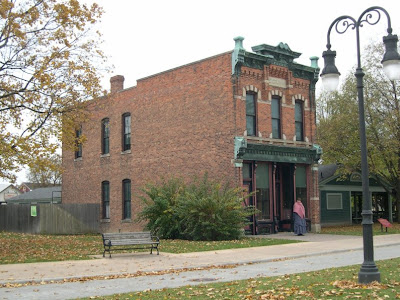Cotswold Cottage (previously known as Rose Cottage)
 Henry Ford desired to show America's ancestral European life and sent his agent, Herbert Morton, to find a typical Cotswold stone house for Greenfield Village. Morton eventually located this circa 1620 Rose Cottage in Chedworth, Gloucestershire, England, and found that it was for sale.
Henry Ford desired to show America's ancestral European life and sent his agent, Herbert Morton, to find a typical Cotswold stone house for Greenfield Village. Morton eventually located this circa 1620 Rose Cottage in Chedworth, Gloucestershire, England, and found that it was for sale.  Once purchased, a builder and expert on Cotswold architecture was hired to restore the house while still in England. Along with the local British builders, they worked to attain an appearance more reflective of the 17th century, which required some major alterations to the house and barn.
Once purchased, a builder and expert on Cotswold architecture was hired to restore the house while still in England. Along with the local British builders, they worked to attain an appearance more reflective of the 17th century, which required some major alterations to the house and barn.  And, once completed, the workers dismantled the structures stone by stone - numbering each one individually - and packed them in gravel sacks. Soon the Cotswold collection was on its way to Dearborn, Michigan (via boat and then train), as were a number of the English builders, eager to help with the reconstruction.
And, once completed, the workers dismantled the structures stone by stone - numbering each one individually - and packed them in gravel sacks. Soon the Cotswold collection was on its way to Dearborn, Michigan (via boat and then train), as were a number of the English builders, eager to help with the reconstruction. By September of 1930, the Cotswold Cottage was rebuilt on Michigan soil, ready to teach American visitors of European life lived more than three hundred (and now, closer to 4oo) years before.
By September of 1930, the Cotswold Cottage was rebuilt on Michigan soil, ready to teach American visitors of European life lived more than three hundred (and now, closer to 4oo) years before. To complete the picture, Ford initially included a stone fence with Cotswold sheep and a sheep dog. This made sense as the family that originally lived in this limestone building were sheepherders.
To complete the picture, Ford initially included a stone fence with Cotswold sheep and a sheep dog. This made sense as the family that originally lived in this limestone building were sheepherders. Today, inside the fence, an Edwardian flower garden surrounds the structures in this group.As beautiful as the outside garden and grounds are, the powers-that-be at the Village have, unfortunately, removed the furnishings from inside that showed visitors life in 17th century England, and, instead, created displays for pewter (!?!). To top it off they turned the patio into a...ahem...tea room.
Today, inside the fence, an Edwardian flower garden surrounds the structures in this group.As beautiful as the outside garden and grounds are, the powers-that-be at the Village have, unfortunately, removed the furnishings from inside that showed visitors life in 17th century England, and, instead, created displays for pewter (!?!). To top it off they turned the patio into a...ahem...tea room. This wonderful learning opportunity has been relegated as background for a beverage. This is not what Henry Ford meant for this beautiful old English cottage.
This wonderful learning opportunity has been relegated as background for a beverage. This is not what Henry Ford meant for this beautiful old English cottage.Hopefully, it will return to its former glory. I have faith that it will.
 And now for a little historical fun fact: Inside the Cotswold Cottage there is a window in the main room where someone by the name of William (I can't quite make out the last name), who, in September of 1806, literally signed his name by etching it into the window.
And now for a little historical fun fact: Inside the Cotswold Cottage there is a window in the main room where someone by the name of William (I can't quite make out the last name), who, in September of 1806, literally signed his name by etching it into the window.Another mystery I will try to uncover.
I took the photo at left by covering the outside of the window with a dark jacket to enhance the etching.
Click HERE to read about the Cotswold Forge
Click HERE to read about the Cotswold Dovecote
.



Comments